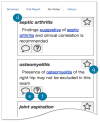Supporting Families in Reviewing and Communicating about Radiology Imaging Studies
- PMID: 28920107
- PMCID: PMC5600522
- DOI: 10.1145/3025453.3025754
Supporting Families in Reviewing and Communicating about Radiology Imaging Studies
Abstract
Diagnostic radiology reports are increasingly being made available to patients and their family members. However, these reports are not typically comprehensible to lay recipients, impeding effective communication about report findings. In this paper, we present three studies informing the design of a prototype to foster patient-clinician communication about radiology report content. First, analysis of questions posted in online health forums helped us identify patients' information needs. Findings from an elicitation study with seven radiologists provided necessary domain knowledge to guide prototype design. Finally, a clinical field study with 14 pediatric patients, their parents and clinicians, revealed positive responses of each stakeholder when using the prototype to interact with and discuss the patient's current CT or MRI report and allowed us to distill three use cases: co-located communication, preparing for the consultation, and reviewing radiology data. We draw on our findings to discuss design considerations for supporting each of these use cases.
Keywords: Adolescents; Families; H.5.m. Information interfaces and presentation (e.g; HCI): Miscellaneous; Patient–Doctor Communication; Radiology Report.
Figures



Similar articles
-
The patient experience of patient-centered communication with nurses in the hospital setting: a qualitative systematic review protocol.JBI Database System Rev Implement Rep. 2015 Jan;13(1):76-87. doi: 10.11124/jbisrir-2015-1072. JBI Database System Rev Implement Rep. 2015. PMID: 26447009
-
Understanding patient needs and gaps in radiology reports through online discussion forum analysis.Insights Imaging. 2021 Apr 19;12(1):50. doi: 10.1186/s13244-020-00930-2. Insights Imaging. 2021. PMID: 33871753 Free PMC article.
-
Promoting and supporting self-management for adults living in the community with physical chronic illness: A systematic review of the effectiveness and meaningfulness of the patient-practitioner encounter.JBI Libr Syst Rev. 2009;7(13):492-582. doi: 10.11124/01938924-200907130-00001. JBI Libr Syst Rev. 2009. PMID: 27819974
-
Online Portals: Gateway to Patient-Centered Radiology.AJR Am J Roentgenol. 2017 Nov;209(5):987-991. doi: 10.2214/AJR.17.18291. Epub 2017 Jul 20. AJR Am J Roentgenol. 2017. PMID: 28726503 Review.
-
[Communication between radiologist and cancer patients].J Radiol. 2006 Feb;87(2 Pt 1):99-104. doi: 10.1016/s0221-0363(06)73978-6. J Radiol. 2006. PMID: 16484930 Review. French.
Cited by
-
Retrieving Lab Test Related Questions from Social Q&A Sites by Combining Shallow Features and Deep Representations.AMIA Annu Symp Proc. 2021 Jan 25;2020:783-792. eCollection 2020. AMIA Annu Symp Proc. 2021. PMID: 33936453 Free PMC article.
-
Patient experience of imaging reports: A systematic literature review.Ultrasound. 2023 Aug;31(3):164-175. doi: 10.1177/1742271X221140024. Epub 2023 Jan 27. Ultrasound. 2023. PMID: 37538965 Free PMC article. Review.
-
Patient Challenges and Needs in Comprehending Laboratory Test Results: Mixed Methods Study.J Med Internet Res. 2020 Dec 7;22(12):e18725. doi: 10.2196/18725. J Med Internet Res. 2020. PMID: 33284117 Free PMC article.
-
It's About the Journey - Capturing Stories of the Fluctuating Experiences of Youth Kidney Transplant Patients.Proc ACM Hum Comput Interact. 2024 Apr;8(CSCW1):213. doi: 10.1145/3653704. Epub 2024 Apr 26. Proc ACM Hum Comput Interact. 2024. PMID: 39950037 Free PMC article.
-
Harnessing mobile health technology to support long-term chronic illness management: exploring family caregiver support needs in the outpatient setting.JAMIA Open. 2020 Dec 5;3(4):593-601. doi: 10.1093/jamiaopen/ooaa053. eCollection 2020 Dec. JAMIA Open. 2020. PMID: 33758797 Free PMC article.
References
-
- Apache cTAKESTM clinical Text Analysis Knowledge Extraction System. Retrieved January 5, 2017 from http://ctakes.apache.org/
-
- Arnold Corey W, McNamara Mary, El-Saden Suzie, Chen Shawn, Taira Ricky K, Bui Alex AT. Imaging informatics for consumer health: towards a radiology patient portal. Journal of the American Medical Informatics Association. 2013;20(6):1028–1036. http://doi.org/10.1136/amiajnl-2012-001457. - DOI - PMC - PubMed
-
- Basu Pat A, Ruiz-Wibbelsmann Julie A, Spielman Susan B, Van Dalsem Volney F, Rosenberg Jarrett K, Glazer Gary M. Creating a patient-centered imaging service: determining what patients want. American Journal of Roentgenology. 2011;196(3):605–610. http://doi.org/10.2214/AJR.10.5333. - DOI - PubMed
-
- Berlin Leonard. Communicating results of all radiologic examinations directly to patients: has the time come? American Journal of Roentgenology. 2007;189(6):1275–1282. http://doi.org/10.2214/AJR.07.2740. - DOI - PubMed
-
- Bickmore Timothy W, Pfeifer Laura M, Jack Brian W. Taking the time to care: empowering low health literacy hospital patients with virtual nurse agents. Proceedings of the ACM International Conference on Human Factors in Computing Systems (CHI '09); 2009. pp. 1265–1274. http://doi.org/10.1145/1518701.1518891. - DOI
Grants and funding
LinkOut - more resources
Full Text Sources
Other Literature Sources
Research Materials
